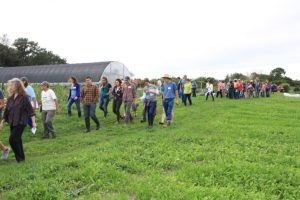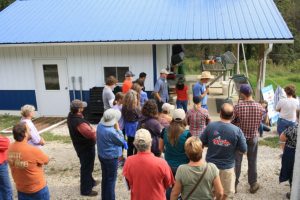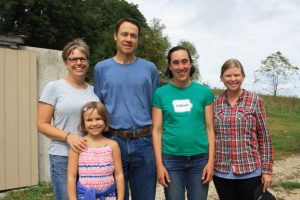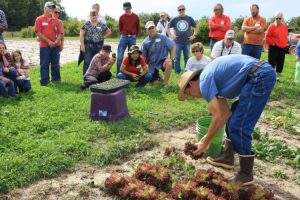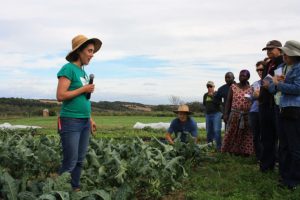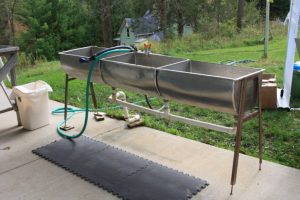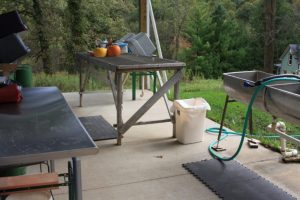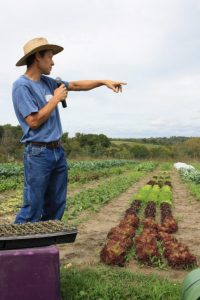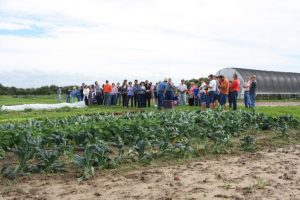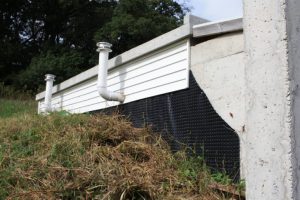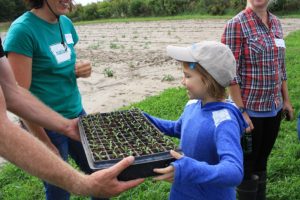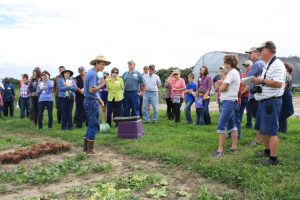Field Day Recap: Patchwork Green Farm, Decorah
Way up in the corner of the state, and way, way up on the top of a hill, you’ll find Erik Sessions’ Patchwork Green Farm. On a soggy, September Sunday when parts of eastern Iowa were dealing with rising flood waters, sixty people sought higher ground by joining Erik and his wife, Sara Peterson, to see their new packing house, underground root cellar, and learn a few tricks for harvest efficiency.
Erik and Sara moved to Decorah in 1997. After buying their 40-acre farm in 2001 and cultivating around 5 acres of vegetable crops, they began dreaming of a better packing facility and root cellar (they started with a lean-to on the side of their garage and a walk-in cooler in the garage). They now have both, and are figuring out how to best use them. “The GAP certifier didn’t like that the wash station was outside, but she said as long as we kept birds from nesting in it, etc., it would be fine.” Their site is tricky; they wanted the packing shed and root cellar near the house and each other, but their land between the production fields and the house is steep… really steep. By building the root cellar into the hill and doing some earth moving for the packing shed across the road, they were able to fit an 11×24 ft covered wash station with a 21×24 enclosed packing shed. The wash station and packing shed are both on a concrete pad.
With an eye toward a future where he doesn’t “want” to lift 50lb bags of potatoes, Erik is devising ways to accomodate a pallet jack between the road, the root cellar, and the packing facility. He installed extra-wide doors on the packing shed, for starters. The packing shed has a washable interior that is rodent-proof and insect-proof, a concrete floor with drains, shatterproof LED lights, a walk-in cooler, two doors, and a window. Other farmers were impressed with the tidiness of the packing shed; the interns told us they had done some “picking up” and cleaning prior to our arrival. “The cement floor was not cheap (see Erik’s field day handout), but boy, is it easy to clean up. The best part of the day is hosing down the floor when we’re finished working,” said Erik.
Outside in the wash area, Erik has a triple sink that drains away and downhill from the pad. “The plumbing needs some work,” admitted Erik, calling it his own hack job, unlike the professional work done for the inside of the packing shed. “It’s on the surface and we’ve stepped on it a few times and cracked the PVC. I need to take some time to get it underground.” They have gutters on the packing shed, and a drain tile under the root cellar. “Even with all the rain we’ve had this summer, we haven’t had any water in the root cellar or the interior of the packing shed – I thank my local contractors for that!” said Erik. They built their drying rack, but ordered the steel-top table from a restaurant supply company. They use anti-fatigue mats at each station, too.
Like the packing shed, the root cellar also has a wide door to accommodate the pallet jack of the future. The door, even used, was the most expensive part of the root cellar. The root cellar is 16×12 ft; Erik had a local contractor help design and build it. “We ended up using concrete forms that have insulation built into it. Most of the insulation is covered on the outside and the inside. The floor and ceiling are also insulated and concrete. The structure is strong enough we could build a second story on top or park our tractor up there.” On the handout, Erik notes the best temperatures for storing various crops. He uses the walk-in cooler with a compressor (in the packing shed) for things that need to be cooled fast, like lettuce with heat from the field. He uses the root cellar for long-term storage, at 45 degrees. That’s where potatoes like to be. For onions and garlic, Erik says, “they’d like it cooler, but temperature stability is more important.” He uses a CoolBot for the root cellar; they’re more efficient to run and can maintain 45 degrees very easily. In the fall he uses the vents to help cool the air inside, to save the CoolBot some work. The air in the root cellar was a little dry last year (as low as 40%). This winter he will experiment with a pan of water. In February he did put a little space heater in the root cellar when the inside temperature got down to 32 degrees. When the temperature outside was above 0 degrees, the space heater was no longer needed.
Erik and one of his interns, Emily Fagan, discussed some of the methods they use to harvest efficiently. Erik says the first thing is that you need to be as physically fit as possible, and you need to stretch and stay flexible. Next, he focuses on how much time they spend bending and standing. Going up and down is a waste of time and energy. Erik prefers to use a stooped position, and to work in that position for as long as possible. Then stand, stretch, and continue. Another farm in the area doesn’t allow their employees to kneel; having one knee down makes you unbalanced, crawling is too slow. Erik also harvests early in the morning; usually bringing greens into the cooler by 7:30am during the summer.
Other tips for field efficiency are on the handout. Erik also demonstrated harvesting Salanova heads using Johnny’s Salanova cutter, and Emily demonstrated working through kale rows to harvest, bundle, check for pests, and clean old growth from the plant.
Special thanks to Oneota Food Coop and Luther College Center for Sustainable Communities for sponsoring this field day.

